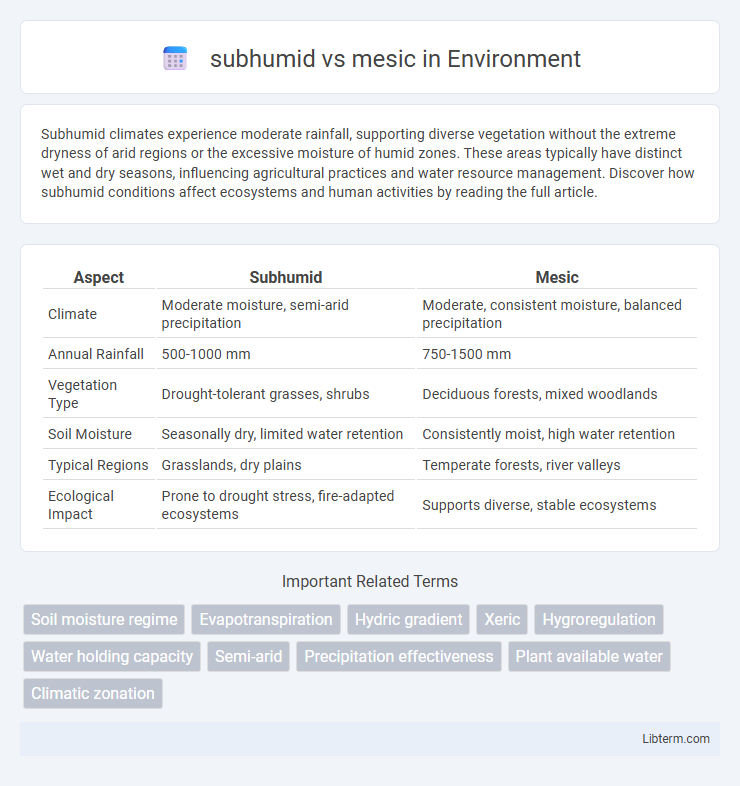Subhumid climates experience moderate rainfall, supporting diverse vegetation without the extreme dryness of arid regions or the excessive moisture of humid zones. These areas typically have distinct wet and dry seasons, influencing agricultural practices and water resource management. Discover how subhumid conditions affect ecosystems and human activities by reading the full article.
Table of Comparison
| Aspect | Subhumid | Mesic |
|---|---|---|
| Climate | Moderate moisture, semi-arid precipitation | Moderate, consistent moisture, balanced precipitation |
| Annual Rainfall | 500-1000 mm | 750-1500 mm |
| Vegetation Type | Drought-tolerant grasses, shrubs | Deciduous forests, mixed woodlands |
| Soil Moisture | Seasonally dry, limited water retention | Consistently moist, high water retention |
| Typical Regions | Grasslands, dry plains | Temperate forests, river valleys |
| Ecological Impact | Prone to drought stress, fire-adapted ecosystems | Supports diverse, stable ecosystems |
Definition of Subhumid and Mesic Climates
Subhumid climates are characterized by moderate moisture availability, receiving precipitation levels that exceed evapotranspiration but remain insufficient to support dense forest growth, typically found in regions with seasonal rainfall patterns. Mesic climates maintain a balanced moisture regime with sufficient and consistent precipitation to support diverse vegetation, including mixed forests, and exhibit moderate temperature ranges without extreme drought or wet conditions. These classifications help ecologists and climatologists distinguish environments based on moisture availability critical for ecosystem sustainability and agricultural planning.
Key Differences Between Subhumid and Mesic Zones
Subhumid zones experience moderate moisture levels with seasonal dry periods, while mesic zones maintain more consistent and balanced moisture availability throughout the year. Vegetation in subhumid zones often includes drought-tolerant species adapted to occasional water stress, whereas mesic zones support lush, diverse plant communities with stable soil moisture. Soil composition in subhumid areas tends to be less rich due to periodic dryness, contrasting with the typically fertile and well-structured soils found in mesic environments.
Geographic Distribution of Subhumid and Mesic Areas
Subhumid regions are predominantly found in transitional zones between arid and humid climates, including parts of the Sahel in Africa, central India, and areas of the southwestern United States. Mesic environments are more widely distributed across temperate regions with moderate moisture availability, such as much of Europe, eastern North America, and parts of East Asia. The geographic distribution of subhumid and mesic areas directly influences vegetation types and land use patterns, with subhumid zones supporting drought-tolerant species and mesic zones favoring more moisture-dependent flora.
Soil Characteristics in Subhumid vs Mesic Regions
Soil in subhumid regions typically exhibits moderate moisture retention with higher organic matter decomposition rates compared to mesic regions, where soils maintain more consistent moisture levels and richer nutrient availability. Subhumid soils often show increased permeability and lower clay content, which influences water drainage and root penetration differently than the denser, more structured soils found in mesic environments. These distinctions affect plant growth dynamics and soil microbial activity, making soil management practices crucially tailored to the specific moisture regimes of each region.
Vegetation Adaptations in Subhumid and Mesic Environments
Vegetation in subhumid environments develops drought-resistant features such as deep root systems and waxy leaf coatings to conserve water during periodic dry spells, while mesic environments support plants with broader leaves and shallower roots adapted to consistent moisture availability. Subhumid species often exhibit seasonal leaf shedding to reduce water loss, whereas mesic vegetation maintains evergreen foliage to optimize photosynthesis year-round. These adaptations reflect the contrasting moisture regimes, influencing plant morphology, physiology, and community composition in each ecosystem.
Water Availability and Hydrology Comparison
Subhumid regions receive moderate rainfall, typically between 500 and 1,000 millimeters annually, resulting in variable water availability with seasonal fluctuations in soil moisture and streamflow. Mesic environments maintain more consistent water availability due to higher annual precipitation, usually exceeding 1,000 millimeters, leading to stable hydrological conditions and sustained groundwater recharge. The hydrology of subhumid areas displays periodic drought stress impacting vegetation and water resource management, whereas mesic zones support continuous moisture regimes that promote diverse and resilient ecosystems.
Impacts on Agriculture: Subhumid vs Mesic Lands
Subhumid lands, characterized by moderate rainfall between 500 and 1000 millimeters annually, often face challenges like periodic drought stress impacting crop yields and necessitating drought-resistant crop varieties and efficient water management techniques. Mesic lands receive more consistent and balanced moisture, promoting higher soil fertility and stable agricultural productivity with less frequent irrigation compared to subhumid regions. Crop selection and farming practices must adapt to these moisture regimes to optimize yield, with subhumid areas requiring strategies to mitigate water scarcity and mesic zones benefiting from more reliable precipitation patterns.
Biodiversity: Species Richness in Subhumid and Mesic Zones
Subhumid zones exhibit moderate species richness due to balanced moisture availability that supports a diverse range of plant and animal life adapted to periodic dry spells. Mesic zones, characterized by consistent and moderate moisture levels, generally sustain higher biodiversity with greater ecological stability and species specialization. Variability in rainfall and soil moisture in subhumid regions leads to unique assemblages, while mesic environments foster dense, complex ecosystems with elevated species richness.
Challenges in Land Management for Subhumid vs Mesic Areas
Land management in subhumid areas contends with irregular rainfall patterns causing periodic drought stress and increased soil erosion, which complicates crop selection and sustainability efforts. Mesic environments benefit from more consistent moisture availability, yet they face challenges from soil compaction and nutrient leaching due to higher water retention and frequent precipitation. Effective management strategies must tailor irrigation, soil conservation, and crop rotation practices to the specific hydrological and climatic conditions inherent to subhumid and mesic zones.
Climate Change Effects on Subhumid and Mesic Regions
Subhumid regions experience more pronounced shifts in precipitation patterns and increased drought frequency due to climate change, leading to greater soil moisture deficits and heightened vulnerability of ecosystems. Mesic regions, characterized by moderate moisture levels, face alterations in seasonal rainfall distribution and temperature rise, potentially disrupting local biodiversity and agricultural productivity. Both subhumid and mesic zones require adaptive land management strategies to mitigate climate-induced stress on water resources and vegetation dynamics.
subhumid Infographic

 libterm.com
libterm.com